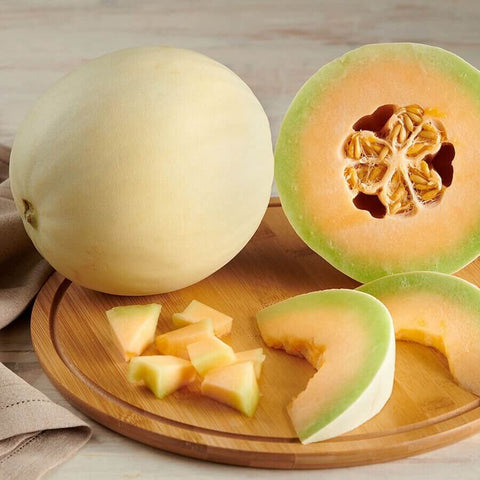

Hortinova
HONEY MONEY F1 (Orange Honeydew)
Cucumis melo
- Early maturity.
- Honeydew x Cantaloup hybrid melon.
- Round shaped fruits
- Fruit weight: 2 kg
- Smooth creamy white skin.
- Firm orange flesh.
- Exceptionally aromatic and sweet taste
- Resistant F1, F2
- Hybrid seeds.
- Natural, Untreated, Non-GMO Seeds.
For early and reliable crops, sow seeds indoors just after the last spring frost. Sow 2 to 3 seeds to 10cm pot and thin to the strongest seed when the vines get to 10 to 12 cm tall. Soil must be warm for proper germination 70°F (21°C). Cool soil will rot the seed. In warmer climates, you may direct sow seeds outdoors as soon as the soil temperature warms in early summer.
PLANT OUT: Reduce water and temperature for a week to harden-off seedlings. Melon vines are very tender and should not be transplanted until all danger of frost has passed and soil temperatures remain consistently above 60°F (16°C). Transplants out, spacing them 18 inches apart, in rows 6 feet apart. Melons do best in well-draining soil that’s a mix between loamy and sandy. (Growing the plants in raised rows ensures good drainage.)
EXPOSURE: Plant in a spot that gets full sun (6-8 hours of direct sunlight per day). To produce the best melons, the plants need all the light they can get. Plus, afternoon sun will dry off leaves, reducing the risk of fungal diseases that comes with wet foliage.
WATER: Watering is key. While the plants are growing, blooming, and setting fruit, they need about 2 inches per square foot of water (about 1.5 gallons) per week. Water in the morning, and try to avoid wetting the leaves, as wet foliage encourages fungal and other diseases. If possible, use drip irrigation to keep plants consistently and evenly watered. Mulching around the plants can help to retain moisture. Reduce watering once fruits are growing. Hot, dry weather produces the sweetest melons. If you’ve had an exceptional amount of rainfall during the ripening stage, this can cause bland fruit.
FEED: To encourage strong growth, blend 4 to 6 inches of composted manure into your melon beds prior to planting. Then add a balanced organic fertilizer (such as a mixed blood meal/bone meal product) every 3 to 4 weeks. Avoid nitrogen-heavy fertilizers, as too much nitrogen can result in lots of foliage and less fruit.
PROTECT: Row covers are a good way to keep pests like squash bugs and vine borers at bay. Mulching the planting site with black plastic will serve multiple purposes: it will warm the soil ahead of planting, hinder weed growth, and keep developing fruits clean.
PRUNING: When opting for larger melons the plants can be pruned. Melons produce a primary stem with many secondary or lateral branches. When pruning melon plants, the idea is to retain the primary vine, remove the first lateral and reduce the size of all the additional secondary branches. Using pruning shears, cut lateral vines that grow from the primary up to the eighth leaf node. Take care not to damage the main stem when cutting back the cantaloupe plants. Leave a few lateral vines untouched. Once the melons begin to form, remove any disfigured or damaged fruit and allow the healthiest fruits to grow. Also, remove any damaged vines.
When rinds begin to change from green to yellow, the melon is typically ripe enough to pick. Be careful not to pick too early, however. Look for a crack in the stem where it attaches to the fruit. This is a sign of ripeness as well. The fruit should be easy to separate from the vine, but if they fall off by themselves, they are usually overripe. Harvest melon when vines are dry and be careful not to damage them. Melons will soften after harvesting but will not continue to sweeten off the vine.
Melon qui fond en boûche avec un goût se rapprochant du melon miel et du cantaloup à la fois, très sucré. Faire attention aux irriguations lorsque le melon devient mature car il peut fendre au champs. Très odorant.
Let customers speak for us
from 23 reviewsWe grow several varieties of various colours of tomatoes, and the contrast of these tomatoes with other colours is fantastic. We've had a very long season with our plants, excellent disease resistance, great flavour.

This review applies to all of the seeds I purchased from Hortinova - beautiful tomatoes, good disease resistance and excellent production. Our field season extended to 10 weeks. We've had comments of excellent flavour from our customers as well, highly recommend any Hortinova seed.

This tomato is good taste tomato. Small red round tomato. Bigger then cherry tomatoes but smaller then regular one. I like it. Perfect for salads and fresh eating. Ordered seeds for next season.

2nd time ordering. Very satisfied with qualify and result. Thank you

BALCONY YELLOW F1 - Hybrid Cherry Tomato Seeds

Delivered very fast, packed very good, in professional condition and quality. Thanks

DUETT - Open Pollinated Radish Seeds

We will see what they are like this summer.

Type crimson de bonne grosseur avec une superbe uniformité et très hâtif. Un des premiers prêt en saison. Semences très petites et peu nombreuses. Goût très sucré et chaire croquante. Chair passant du rose au rouge en cours de saison. Les plants sont forts et très vigoureux avec des grosses feuilles.

Vigueur des plants impressionante avec des fruits résistants aux fissures et aux dommages. Très bonne conservartion et goût très sucré lorsque les nervures deviennent orange. Peu être récolté lorsque les nervures sont vertes également. Cavité des semences très compacte et petite laissant beaucoup de chair.

Melon qui fond en boûche avec un goût se rapprochant du melon miel et du cantaloup à la fois, très sucré. Faire attention aux irriguations lorsque le melon devient mature car il peut fendre au champs. Très odorant.

Avec son apparence côtellée, son très gros calibre et ça couleur rose, cette tomate se démarque des autres sur les tablettes. Variété plus résistante à la pourriture apicale que la plus part des autres tomates roses. Bon ensemble de résitance aux maladies également.

Tomate noire dont les faces qui ne sont pas exposé au soleil passent du vert au rouge lorsque mature donnant un aspect unique aux fruits. Charactéristiques similaires à la Barrio avec un goût superbe sans acide. Les clients l'on adoré.

Superbe adaptabilité et excellente résistance aux maladies. Fruits uniformes qui ne fendent pas, bonne conservation. Ajoutez à cela un goût unique avec une légère acidité et une pointe sucré.















